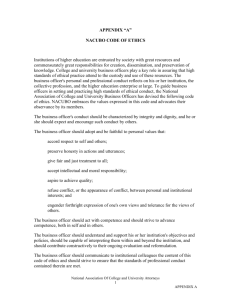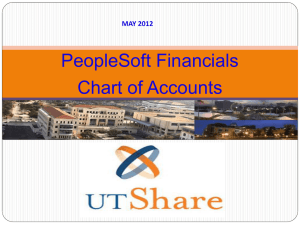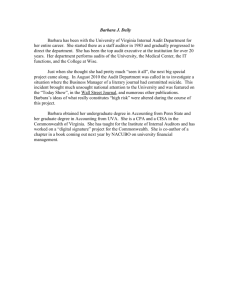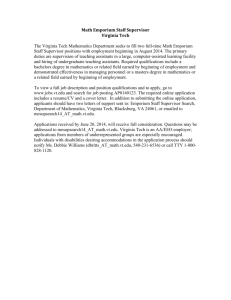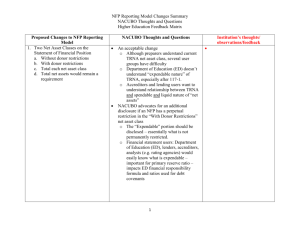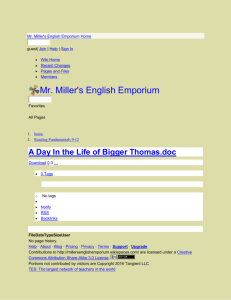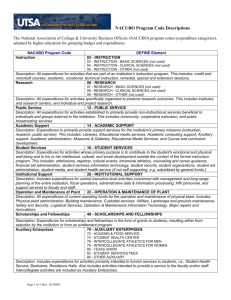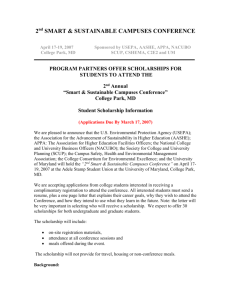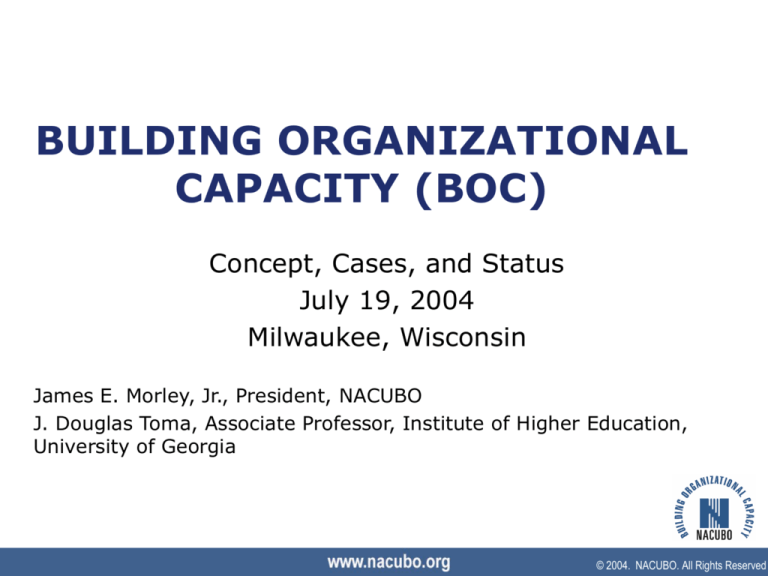
BUILDING ORGANIZATIONAL
CAPACITY (BOC)
Concept, Cases, and Status
July 19, 2004
Milwaukee, Wisconsin
James E. Morley, Jr., President, NACUBO
J. Douglas Toma, Associate Professor, Institute of Higher Education,
University of Georgia
© 2004. NACUBO. All Rights Reserved
AGENDA
• Why BOC?
• Why Business Officers and NACUBO?
• What is BOC?
• The BOC Project
• The Future of BOC
© 2004. NACUBO. All Rights Reserved
WHY BOC?
• Institutional imperatives
• Stakeholder expectations
• New leadership requirements
© 2004. NACUBO. All Rights Reserved
INSTITUTIONAL IMPERATIVES
• Economics
• Competition
• Technology
• Rapid change
• Leadership turnover
© 2004. NACUBO. All Rights Reserved
STAKEHOLDER EXPECTATIONS
• Students and parents
• Faculty and staff
• Employers
• Public policy makers
• Other communities
© 2004. NACUBO. All Rights Reserved
NEW LEADERSHIP REQUIREMENTS
• Institutional focus
• Complex organization
• Decentralized decision making
• Allocating scarce resources
• Continuous improvement
© 2004. NACUBO. All Rights Reserved
BOC—Member Survey Feedback
Additional Challenges/Issues
Competing issues and balance
between academic and business
administration
62%
Increasing complexities of job
59%
Dealing with human resource issues
49%
Other’s lack of understanding of
business processes at my institution
44%
© 2004. NACUBO. All Rights Reserved
WHY BUSINESS OFFICERS AND
NACUBO?
• CBO as institutional leader and cabinet
member
• Administrative effectiveness evolving and new
expected role of CBO
• Skill development needs a campus home
• NACUBO has national leadership support to
guide collaborative program development
© 2004. NACUBO. All Rights Reserved
WHAT IS BOC?
• Working hypothesis—eight interrelated elements
offer an overall framework for defining and
understanding organizational capacity in terms of
Mission/Vision/Goals
Governance
Structure
Policies
Processes
Systems
Infrastructure
Culture
© 2004. NACUBO. All Rights Reserved
ORGANIZATIONAL CAPACITY
The capability of individual higher
education institutions to anticipate,
plan for, and respond effectively to
institutional challenges in ways that
have continuing impact
© 2004. NACUBO. All Rights Reserved
BOC INTERRELATIONSHIPS
Mission/
Vision/
Goals
Governance
Culture
Structure
Infrastructure
Policies
Systems
Processes
© 2004. NACUBO. All Rights Reserved
Many core activities define the capacity to
respond to mission requirements. For example,
Strategic planning
Faculty hiring, development, and retention
Facilities planning, design, and construction
Financial planning, reporting, and control
Enrollment management
© 2004. NACUBO. All Rights Reserved
THE BOC PROJECT
• Case study approach
• Organization
• Communications and dissemination
© 2004. NACUBO. All Rights Reserved
BOC CASE STUDY APPROACH
• The College of New
Jersey
• Virginia Tech
© 2004. NACUBO. All Rights Reserved
THE COLLEGE OF NEW
JERSEY
EWING, NEW JERSEY
© 2004. NACUBO. All Rights Reserved
THE SETTING: THE COLLEGE OF
NEW JERSEY
• 5,900 undergraduate; 850 graduate students
• Ranked in top public comprehensive colleges
in the northeast by U.S. News & World Report
• Ranked 19 out of 100 best public universities
and colleges by Kiplinger’s in 2002
© 2004. NACUBO. All Rights Reserved
THE SETTING: THE COLLEGE OF
NEW JERSEY
• 95 percent of TCNJ students are from in-state
• 20 percent of TCNJ students are members of
minority groups
• 324 full-time faculty
• 12:1 student to faculty ratio
© 2004. NACUBO. All Rights Reserved
THE SETTING: THE COLLEGE OF
NEW JERSEY
• 50 undergraduate degree programs in three
schools of liberal arts and sciences (art,
music, and media; culture and society; and
science) and four professional schools
(business; education; engineering; and
nursing)
• In 1996, the institution changed its name
from Trenton State College to TCNJ
© 2004. NACUBO. All Rights Reserved
TCNJ
MISSION/VISION/GOALS
• Liberal arts focus in the context of
professional schools
• Mission development for schools, etc.,
consistent with overall mission
© 2004. NACUBO. All Rights Reserved
TCNJ
GOVERNANCE
• Keep many stakeholders engaged in moving
towards the vision and mission
• Stakeholders included in communication,
advisory, and decision roles
© 2004. NACUBO. All Rights Reserved
TCNJ
STRUCTURE
• Staff, schools, and departments are
effectively aligned in response to the
“Transformation”
• The “financial structure” of separate fees is
quite unique
© 2004. NACUBO. All Rights Reserved
TCNJ
POLICIES (AND PRACTICES)
• Hiring the right people for leadership
positions
• Changing faculty load from 4x4 to 3x3
• Maintaining the student faculty ratio of 12:1
© 2004. NACUBO. All Rights Reserved
TCNJ
PROCESSES
• Communications to all levels of stakeholders
on a continuous basis
• Assessment is potentially the key process that
holds things together
• “Training” of the leaders going forward
© 2004. NACUBO. All Rights Reserved
TCNJ
SYSTEMS
• Adapt from the credit hour to unit as a course
load measure
• Changing from 4x4 to 3x3
© 2004. NACUBO. All Rights Reserved
TCNJ
INFRASTRUCTURE
• The College of New Jersey campus with the
emphasis on small classrooms and intimate
spaces
• Other items such as the “infrastructure for
assessment” and “financial infrastructure”
© 2004. NACUBO. All Rights Reserved
TCNJ
CULTURE
• A strong sense of community and buy-in to
the mission
• An engaged campus in a culture of
participatory governance
• A culture of being willing to deal with
increasingly difficult challenges
© 2004. NACUBO. All Rights Reserved
VIRGINIA TECH
MATH EMPORIUM
Blacksburg, Virginia
© 2004. NACUBO. All Rights Reserved
THE SETTING: VIRGINIA TECH
• 21,000 undergraduate, 6,000 graduate;
2,000 international
• Ranked as top 50 research university
• Focus on agriculture and engineering
• Pronounced outreach mission; Blacksburg
Electronic Village
© 2004. NACUBO. All Rights Reserved
THE INITIATIVE: MATH
EMPORIUM
• Established Fall, 1997
• 60,000 square foot computer laboratory in
former department store
• 550 Apple iMac workstations arranged in
hexagonal pods
• Open around-the-clock
© 2004. NACUBO. All Rights Reserved
THE INITIATIVE: MATH
EMPORIUM
• Course taught fully or partially at the
Emporium
• For Emporium courses, weekly lessonpractice-quiz cycle with periodic exams -- all
web based
• Encouraged to solve practice problems
generated from quiz and test database; more
hands-on than lecture format
© 2004. NACUBO. All Rights Reserved
THE INITIATIVE: MATH
EMPORIUM
• Online testing; linked with learning outcomes
and instantaneous feedback
• Unlimited practice tests
• 4,500 students and growing
© 2004. NACUBO. All Rights Reserved
THE INITIATIVE: MATH
EMPORIUM
• Just-in-time, one-on-one help from faculty
and graduate students stationed at Emporium
• Factored into teaching load
• Faculty role changes from “one-to-many
broadcaster to a one-to-one short-term tutor”
• Logic of learning community
© 2004. NACUBO. All Rights Reserved
VIRGINIA TECH MATH EMPORIUM
MISSION/VISION/GOALS
• Institutional
• College
• Departments
• Math Emporium
© 2004. NACUBO. All Rights Reserved
VIRGINIA TECH MATH EMPORIUM
GOVERNANCE
• Start-up
• Ongoing
© 2004. NACUBO. All Rights Reserved
VIRGINIA TECH MATH EMPORIUM
STRUCTURE
• Start-up
Institutional
Project
• Ongoing
© 2004. NACUBO. All Rights Reserved
VIRGINIA TECH MATH EMPORIUM
POLICIES (AND PRACTICES)
• General education
requirements
• Budget and planning
• Registrar
• Facilities management
© 2004. NACUBO. All Rights Reserved
VIRGINIA TECH MATH EMPORIUM
PROCESSES
• Class scheduling
• Course upgrade
• Project management
© 2004. NACUBO. All Rights Reserved
VIRGINIA TECH MATH EMPORIUM
SYSTEMS
• Student records
• Financial
© 2004. NACUBO. All Rights Reserved
VIRGINIA TECH MATH EMPORIUM
INFRASTRUCTURE
• Financial
• Facilities
• Faculty and staff
• IT equipment and software
© 2004. NACUBO. All Rights Reserved
VIRGINIA TECH MATH EMPORIUM
CULTURE
• Institutional
• College
• Department
• Math Emporium
• Student
© 2004. NACUBO. All Rights Reserved
BOC PROJECT ORGANIZATION
• Project Director
James E. Morley, Jr.
• Steering Committee
Chancellor Kenneth A. “Buzz” Shaw, Chair
Syracuse University
• Editorial Board
Dr. Marvin Lazerson, Chair
University of Pennsylvania
• Strategy Consultant
Anthony Knerr, Managing Director
Anthony Knerr & Associates
© 2004. NACUBO. All Rights Reserved
BOC PROJECT ORGANIZATION
• Institute of Higher Education, University of
Georgia
J. Douglas Toma
Michael Massey
• Evaluation
Karen Paulson, NCHEMS
• IT Support
Craig Dellorso, NACUBO
SunGard SCT
© 2004. NACUBO. All Rights Reserved
BOC PROJECT ORGANIZATION
Faculty Team
Greg Dubrow
Matthew Hartley
Adrianna Kezar
Kevin Kinser
Michael Massey
Christopher Morphew
Kate Shaw
Doug Toma
Kelly Ward
Lisa Wolf-Wendel
© 2004. NACUBO. All Rights Reserved
BOC COMMUNICATIONS AND
DISSEMINATION
Web site capability:
Case presentations
Research links
Case team communications links
Sponsored by SunGard SCT
© 2004. NACUBO. All Rights Reserved
BOC COMMUNICATIONS AND
DISSEMINATION
• Overview document
• Case write-ups
• Workshops and seminars
• Presentations at higher education association
meetings
• Campus discussions
© 2004. NACUBO. All Rights Reserved
THE FUTURE OF BOC
• Research
• As a vocabulary
• As a checklist
• As a new initiative planning
tool
© 2004. NACUBO. All Rights Reserved
THE FUTURE OF BOC
• Historical cases
• “Go Forward” cases
• Create and activate web site
• Steering Committee
• Editorial Board
• Faculty
• Graduate school program linkage
© 2004. NACUBO. All Rights Reserved
THE FUTURE OF BOC
National Association Collaboration
• American Council on Education (ACE)
• National Association of State Universities and Land
•
•
•
•
Grant Colleges (NASULGC)
Association of American Universities (AAU)
American Association of Community Colleges (AACC)
American Association of State Colleges and
Universities (AASCU)
Council of Independent Colleges (CIC)
© 2004. NACUBO. All Rights Reserved
WHAT YOU CAN DO TO HELP
• Comments on today
• Look for the future web site:
http://www.buildingorganizationalcapacity.org
• Communicate from campus
discussions
What will help you use this framework?
© 2004. NACUBO. All Rights Reserved
BUILDING ORGANIZATIONAL CAPACITY
A project of the National Association of College and
University Business Officers
© 2004. NACUBO. All Rights Reserved

